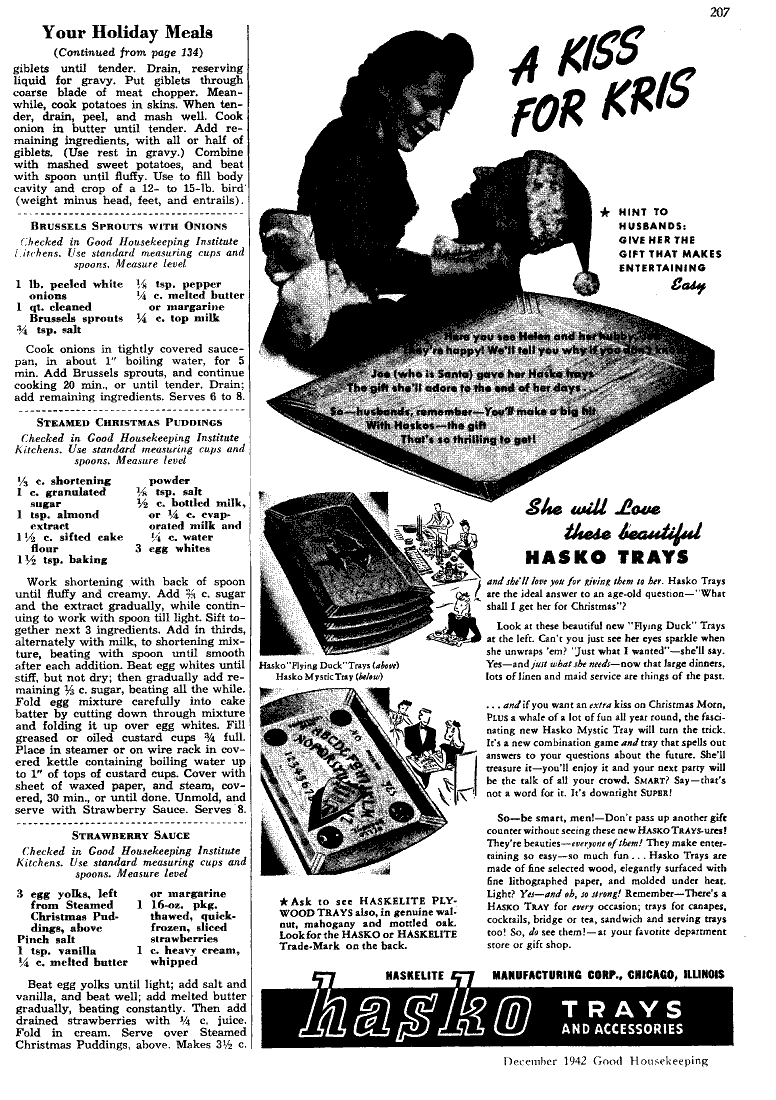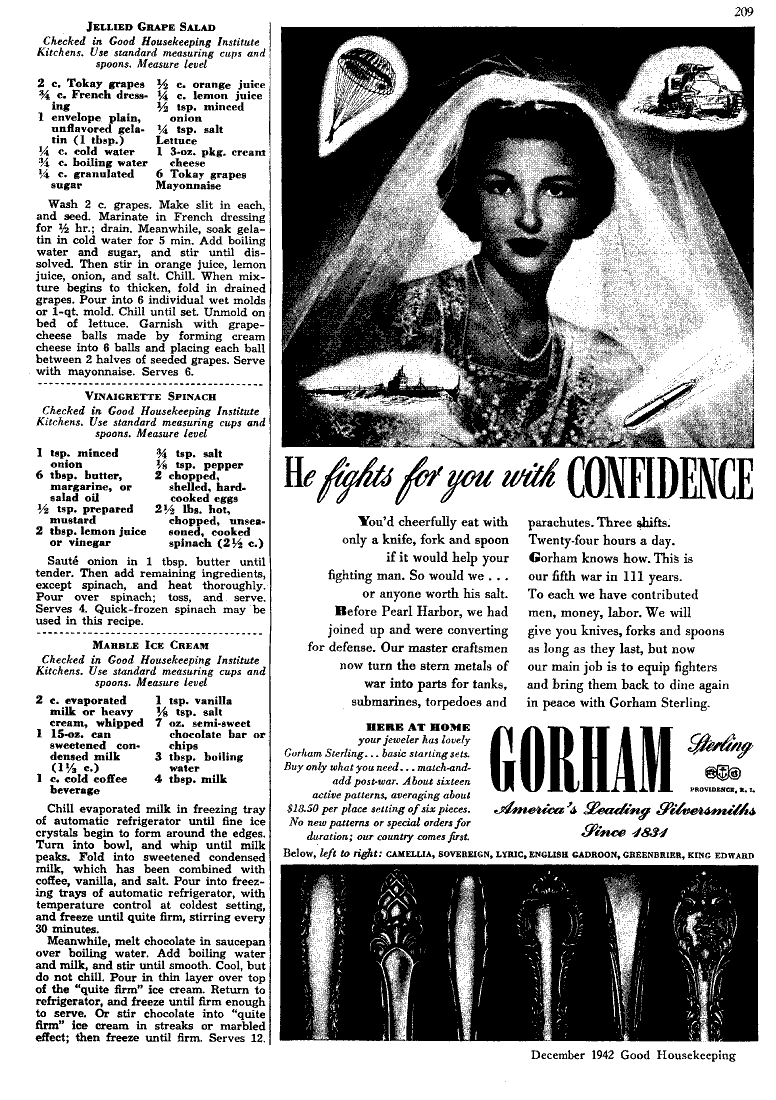|
This article, from the December, 1942 issue of Good Housekeeping magazine, illustrates the first Christmas under rationing for Americans. Although the Japanese had attacked Pearl Harbor on December 7, 1941, rationing did not go into effect until 1942. Good Housekeeping set the standard for women's magazines in the period, and had the still-famous "Good Housekeeping Seal of Approval" to its name. But in this instance, the magazine, as many other publications in the period, served as an arm of the government's propaganda machine. Here, the article outlines the Basic 7 nutrition recommendations and gives advice for how to shop around shortages and rationing. The article has no author, which is another clue that it probably came straight from Uncle Sam's on-staff nutritionists and home economists. "PLAN YOUR HOLIDAY MEALS THIS WAY AND YOU'LL MEET Uncle Sam's recommendations FOR NUTRITIOUS MEALS""Planning Is Important. It's imperative this year to cut down on deliveries and trips to market, to shop early in the week, so there will be less crowding in the stores, to stock up on staples, and to plan for the purchase of perishables, so the refrigerator is never overcrowded. And we should not go back on Uncle Sam by failing to measure up to his recommendations for truly nutritious meals. All this means planning ahead. So before you go to market, plan your meals, if possible, for the entire holiday weekend, Thursday to Monday. Plan each day as a unit, with an eye on the government food chart. Then make out your market listsone for staples, another for perishables. And off you go with your Victory marketbag or basket! "Your Grocer's Shelves. In checking your market list at the grocer's, you may find that some items are missing. Neither the grocer nor the food manufacturers can help this. Before products get to the grocer's shelves this year, Uncle Sam has appropriated what he needs for the armed forces and for our allies. This means that little, if any, of some foods is left for civilians. However, you still will find such a wide variety in foods on the grocer's shelves that you easily can choose substitutes. Here is where Uncle Sam's nutrition chart will come to your aid, so take it to market with you. Don't be surprised, either, if you find old favorites in new containerssome in glass instead of tin, some in various types of paper package. Whatever the kind of package, the quality of your favorite brands will not fail you. "Your Pantry Shelf. While you are giving your order, don't forget to include a reserve supply of those staple groceries you depend on regularly or in an emergency. This practice is real conservation. It will save trips to market, deliveries, and phone calls. Tin Cans Are Precious. You all know that tin and steel are scarce and that the tin cans you have been depending on are made of steel plated with tin. Because of this scarcity, used cans are being salvaged. The tin plating is removed, and this, with the steel, is used for new cans. We are told that 250 used cans will produce 200 new ones. Need we urge you then to save every can? Remove labels, wash cans thoroughly, remove top and bottom, and then flatten each can with the foot until the sides nearly meet. Be sure to leave a small space, as this is necessary for the detinning process. Remember, too, that unless the cans are really clean, they cannot be salvaged. If collections are tardy, take the cans in your market basket to a collection center. Saving cans is your patriotic privilege. "Uncle Sam's Food Rules. Use these rules in planning each day's menus: Milk and Milk Products - at least a pint for everyone - more for children - or cheese or evaporated or dried milk. Oranges, Tomatoes (and Tomato Juice), Grapefruit - or raw cabbage or salad greens - at least one of these. Green or Yellow Vegetables (market, canned, or quick-frozen) - one big helping or more, some raw, some cooked. Other Vegetables, Fruits (fresh, dried, canned, or quick-frozen) - potatoes, other vegetables or fruits in season. Bread and Cereal (including cereal restored to whole-grain nutritive value) whole-grain products or enriched white bread and flour. Meat, Poultry, or Fish - dried beans, peas, or nuts occasionally. Eggs - at least 3 or 4 a week, cooked as you choose - or in "made" dishes. Butter and Other Spreads (including margarines fortified with vitamin A) vitamin-rich fats, peanut butter, and similar spreads. Then eat other foods you also like. "Our Planned Holiday Menus. We followed the above rules in planning the menus given below. To illustrate: granting that breakfast provided a citrus fruit or tomato juice, a cereal, but no egg, we have eggs in the Cheese Bread Pudding, and we have meat for luncheon and cheese for dinner, to meet the protein quota for the day. Minerals and vitamins are taken care of with the carrot cole slaw, molasses cookies, fruit gelatin (gelatin is an excellent carrier of fruit, etc.), vegetable-juice cocktail, broccoli, salad, apples, etc. Enriched flour is used in shortcake, pie, cookies, and cheese pudding, and butter or margarine is used both as a spread and as an ingredient in some of the dishes. Milk is served at both meals and is used in the cheese pudding. Broccoli is the green vegetable. Isn't it simple to check your meals for their food value? And isn't it a great reward to know that your family is well fed? So why not make this part of your meal planning? "Now for our holiday menus, with recipes. DAY BEFORE CHRISTMAS Luncheon *Hamburger Shortcakes Carrot Cole Slaw Fruit or * Coffee Almond Jelly Molasses Cookies Milk Dinner Hot Vegetable-Juice Cocktail *Cheese Bread Pudding Broccoli Tossed Lima-Bean and Beet Salad Bread Sticks * Deep-Dish Quince-Apple Pie Milk CHRISTMAS DAY Dinner * Cranberry-Juice Cocktail * Carrot-Cheese Hors d'Oeuvres Roast Turkey *Sweet-Potato Stuffing Giblet or Mushroom Gravy * Brussels Sprouts with Onions String-Bean Succotash Celery Pickles Pickled Fruits Enriched Bread * Steamed Christmas Puddings with * Strawberry Sauce Roasted Walnuts Coffee Evening Snack (For Those Who Wish It) Oyster Stew Toasted Crackers Fruit Bowl Coffee DAY AFTER CHRISTMAS Luncheon * Luncheon Rarebit Sandwiches Celery Chocolate-Flavored Milk Drink Dinner Sauteed Lamb's Liver * Mashed Potato-Turnips Canned or Quick-Frozen Peas Whole-Wheat Bread *Jellied Grape Salad Milk Coffee SUNDAY AFTER CHRISTMAS Dinner * Turkey Fricassee on Crumb Noodles * Vinaigrette Spinach Baked Acorn Squash Enriched Bread Canned Cranberry Sauce * Marble Ice Cream Coffee Supper Hot Canned Consomme Madrilene Canned-Tongue and Lettuce Sandwiches Cookies Milk Coffee *Recipe given in article" I won't transcribe all of the recipes here (there are so many of them!), but most are typical of the 1940s and designed to use up leftovers (Turkey Fricassee on Crumb Noodles) or organ meats like liver or canned tongue. The meals themselves, except for dinner Christmas Day, are also very simple, emphasizing starches and vegetables livened up with cheese and a few interesting desserts. The "Dinner" served on Christmas Day was likely intended to be a noon or afternoon meal. Hence the "Evening Snack" of oyster stew ("for those who wish it" - in case they're too full still from dinner) - an American Christmas tradition (usually using canned oysters) dating back to the Victorian era. Conspicuously absent from this menu is the plethora of Christmas cookies we are now so used to. But perhaps that's a good thing. Perhaps if we adopted the 1942 stick-to-your-ribs steamed Christmas pudding, it might leave us too full for cookies anyway. How do your holiday dinner traditions line up to 1942? Do you have any traditional ways of dealing with leftovers? I'm trying to convince my family to do "snack Christmas" this year and avoid the big meal. There are only a few of us, so it doesn't make sense to cook so many dishes. Everyone prefers my mother-in-law's dill dip with rye bread, my brother-in-law's hot and cheesy jalapeno dip with Ritz crackers, and other snacks like Christmas cookies, port wine cheese-stuffed celery, and salted nuts, anyway. We'll see how successful I am! Many thanks to Cornell University for digitizing ALL of Good Housekeeping, plus a bunch of other amazing food- and home-economics-related titles at the Home Economics Archive. If you enjoyed this World War Wednesday post, consider becoming a member of The Food Historian! You can join online here, or you can join us on Patreon. Members get access to members-only sections of this website, special updates, plus discounts on future events and classes. And you'll help support free content like this for everyone. Join today!
0 Comments
Your comment will be posted after it is approved.
Leave a Reply. |
AuthorSarah Wassberg Johnson has an MA in Public History from the University at Albany and studies early 20th century food history. Archives
July 2024
Categories
All
|







 RSS Feed
RSS Feed